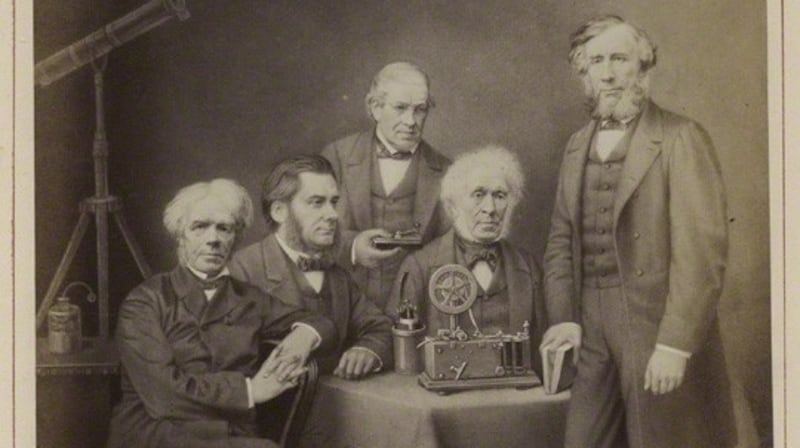A new weekly series for Irish Times Abroad profiles an Exraordinary Emigrant from Irish history, based on entries from the Royal Irish Academy’s Dictionary of Irish Biography.
He reported the effect of Penicillium 50 years before Alexander Fleming, proved Louis Pasteur's germ theory when Pasteur himself failed, explained why the sky is blue, and was the first to show the greenhouse effect. He was a pioneering mountaineer and a gifted teacher. But Carlow's John Tyndall has a surprisingly low profile.
Born in August 1820 at Leighlinbridge, he was educated in a one-room school at Ballinabranagh, in English, logic, book-keeping, drawing, surveying and associated mathematics. At 19, Tyndall joined the local Ordnance Survey office, later moving to Youghal, Co Cork and, in 1842, to Lancashire in England.
His interest in physics and engineering education began in 1847 at Queenwood College in Hampshire. Tyndall became superintendent of the engineering laboratory, and along with Edward Frankland, established the first programme of practical science and engineering in Britain and Ireland.
Frankland and Tyndall left Queenwood in 1848 to attend Marburg University in Germany, where Tyndall studied chemistry under Robert Bunsen inventor of the Bunsen burner. He moved towards physics to produce his first paper on diamagnetism before returning to Britain in 1851. In 1853, he was elected chair of natural philosophy at the Royal Institution of Great Britain.
The X-Club
After the publication of Charles Darwin's On the Origin of Species in 1859, nine London-based evolutionists were organised by Tyndall and Frankland for the defence of the "great hypothesis". They became known as the "X-Club" - because of the nine members plus their always absent "Xth" member, Darwin. The members adopted nicknames (Tyndall's was Xcentric and Frankland's Xpert), and each defended different aspects of the theory.

Tyndall’s research on radiation through gases and vapours from 1860 had provided the experimental basis for meteorology. He proceeded to measure the absorptions and emissions of all known gases and vapours. He helped to disprove Macedonio Melloni’s contention that infrared radiation was a different form of energy to visible rays, but showed the Italian’s results were otherwise valid. Tyndall and Melloni can be considered the fathers of infrared analysis and spectroscopy.
Tyndall opened up the debate on the “greenhouse effect”, and used his knowledge on the absorptive capacity of water vapour to explain meteorological conditions in deserts. He turned to shorter wavelengths and found that these rays of ultra violet light caused photochemical reactions. The resulting clouds of small particles scattered visible light to produce colours including the blue of the sky, now known as “Tyndall blue”. He also pointed out, with amazing prescience, that space would be black.
Tyndall played a central role in setting up the evolutionist journal Nature. He formally broke with religion in aiding Thomas Henry Huxley to formulate a new world-view of materialistic "Humanism". Tyndall joked that he had been an agnostic long before his friend invented the word.
From 1859, Tyndall joined Huxley in preparing a regular science column for the Saturday Review. His essays were collected in books still widely read, Fragments of science for unscientific people (1871) and New fragments of science (1892). Tyndall also held a chair of physics in the Royal School of Mines (later Imperial College), where he lectured from 1859. His lectures to children on sound, light, heat and electricity were especially well received, and for many years he delivered a Christmas lecture that grew into a series of school textbooks.
Inventions
Tyndall was also a prolific inventor of equipment, including the “light-pipe” (1854), which led to modern fibre optics, and the forerunner of modern respirators (1871). His research in sound was important in the improvement of fog signals. He refused to patent any of his inventions.
In 1871 Tyndall was persuaded by Louis Pasteur to help disprove his theory of "spontaneous generation", which held that living organisms could arise from inorganic matter. Tyndall succeeded in devising methods of rigorous sterilisation and was able to prove Pasteur's "germ theory". Pasteur's process of sterilisation had just a single heat stage, so did not kill the spores of bacteria. Tyndall showed in 1877 that the only reliable method of sterilisation was by intermittent heating.
He worked closely with Huxley and Joseph Lister - a British surgeon and a pioneer of antiseptic surgery after whom the mouthwash Listerine was named - and all three independently reported the effect of Penicillium some 50 years before the same observation by Alexander Fleming.
Mountaineering
Aged 48, Tyndall completed the first traverse of the Matterhorn from the Italian side on July 29, 1868 and descended to Zermatt. His climbing career included three ascents of Mount Blanc, the first solo ascent of Monte Rosa (twice in 1858), and the first ascent of the Weisshorn (1861). Tyndall added to the sport by his development of climbing techniques, and his mountain books, The Glaciers of the Alps and Mountaineering, were best-sellers.
Tyndall as a young man was anxious to leave Ireland, and in later life he became an opponent of Home Rule. One enduring link was as scientific adviser to the Board of Trade and Trinity House, where he supported a gas illumination system for lighthouses, developed by John Wigham.
Tyndall married Louisa Hamilton in 1876, who commemorated him after his death (in 1893, from an accidental solvent overdose) with monuments at Bel Alp, Switzerland, and at Leighlinbridge. He is remembered in Cork by UCC's research flagship, the Tyndall Institute.
Based on Norman McMillan’s biography of John Tyndall in the Royal Irish Academy’s Dictionary of Irish Biography












